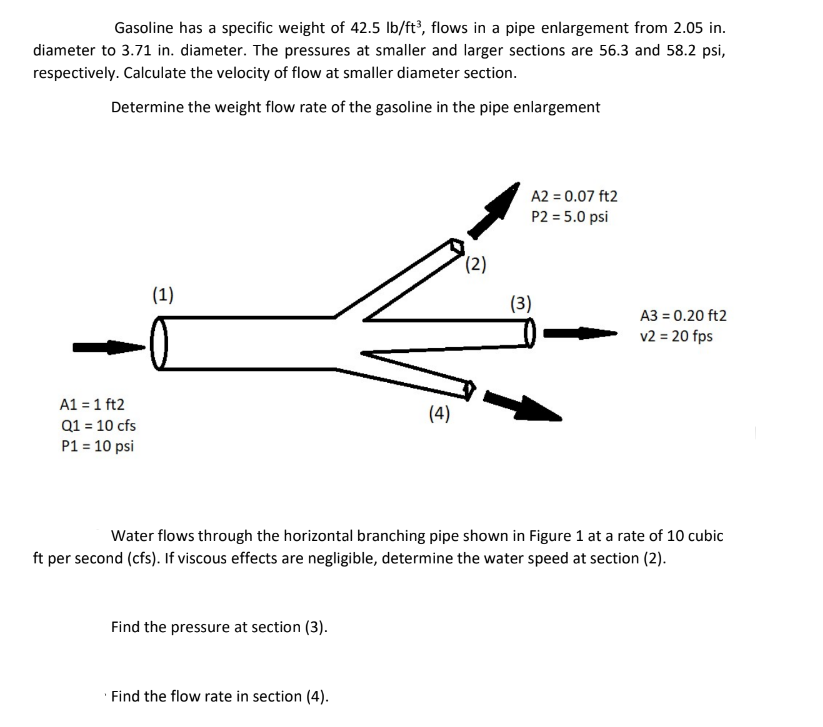Gasoline has a specific weight of 42.5 lb/ft³, flows in a pipe enlargement from 2.05 in. diameter to 3.71 in. diameter. The pressures at smaller and larger sections are 56.3 and 58.2 psi, respectively. Calculate the velocity of flow at smaller diameter section. Determine the weight flow rate of the gasoline in the pipe enlargement A1 = 1 ft2 Q1 = 10 cfs P1 = 10 psi (1) (4) (2) A2 = 0.07 ft2 P2 = 5.0 psi (3) A3 = 0.20 ft2 v2 = 20 fps Water flows through the horizontal branching pipe shown in Figure 1 at a rate of 10 cubic
Gasoline has a specific weight of 42.5 lb/ft³, flows in a pipe enlargement from 2.05 in. diameter to 3.71 in. diameter. The pressures at smaller and larger sections are 56.3 and 58.2 psi, respectively. Calculate the velocity of flow at smaller diameter section. Determine the weight flow rate of the gasoline in the pipe enlargement A1 = 1 ft2 Q1 = 10 cfs P1 = 10 psi (1) (4) (2) A2 = 0.07 ft2 P2 = 5.0 psi (3) A3 = 0.20 ft2 v2 = 20 fps Water flows through the horizontal branching pipe shown in Figure 1 at a rate of 10 cubic
Engineering Fundamentals: An Introduction to Engineering (MindTap Course List)
5th Edition
ISBN:9781305084766
Author:Saeed Moaveni
Publisher:Saeed Moaveni
Chapter10: Force And Force-related Variables In Engineering
Section: Chapter Questions
Problem 26P: SAE 30 oil is contained in a cylinder with inside diameter of 1 in. and length of 1 ft. What is the...
Related questions
Concept explainers
Question
Please help me answer this and please also include some explanation on the side as you answer it. Thank you!

Transcribed Image Text:Gasoline has a specific weight of 42.5 lb/ft³, flows in a pipe enlargement from 2.05 in.
diameter to 3.71 in. diameter. The pressures at smaller and larger sections are 56.3 and 58.2 psi,
respectively. Calculate the velocity of flow at smaller diameter section.
Determine the weight flow rate of the gasoline in the pipe enlargement
A1 = 1 ft2
Q1 = 10 cfs
P1 = 10 psi
(1)
Find the pressure at section (3).
(4)
Find the flow rate in section (4).
(2)
A2 = 0.07 ft2
P2 = 5.0 psi
(3)
Water flows through the horizontal branching pipe shown in Figure 1 at a rate of 10 cubic
ft per second (cfs). If viscous effects are negligible, determine the water speed at section (2).
A3 = 0.20 ft2
v2 = 20 fps
Expert Solution
This question has been solved!
Explore an expertly crafted, step-by-step solution for a thorough understanding of key concepts.
This is a popular solution!
Trending now
This is a popular solution!
Step by step
Solved in 2 steps with 1 images

Knowledge Booster
Learn more about
Need a deep-dive on the concept behind this application? Look no further. Learn more about this topic, civil-engineering and related others by exploring similar questions and additional content below.Recommended textbooks for you

Engineering Fundamentals: An Introduction to Engi…
Civil Engineering
ISBN:
9781305084766
Author:
Saeed Moaveni
Publisher:
Cengage Learning

Engineering Fundamentals: An Introduction to Engi…
Civil Engineering
ISBN:
9781305084766
Author:
Saeed Moaveni
Publisher:
Cengage Learning